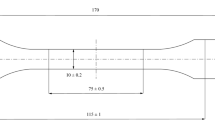Abstract
The main objective to guarantee a high efficiency in the press shop is to produce sheet metal parts without failure. The feasibility of sheet metal parts is nowadays ensured during the development process by a comparison of the occurring strains in the simulation with the Forming Limit Diagram (FLD). The principle of the experimental procedure to determine the FLD is standardized in ISO 12004–2 [1]. This procedure is only valid with high accuracy for proportional unbroken strain paths. However, in most industrial forming operations non-linear strain paths occur. To resolve this problem, a phenomenological approach was introduced by Volk [2], the so-called Generalized Forming Limit Concept (GFLC). Localized necking and the remaining formability for any arbitrary non-linear strain path can be predicted with the GFLC. Furthermore, experimental investigation of multi-linear strain paths appears highly complex in practice and involves a range of testing equipment, e.g. different specimens, testing machines and tools. In this paper an alternative method is introduced by using a cruciform specimen and a draw bead tool on a sheet metal testing machine. The different draw bead heights allow the creation of arbitrary strain states, which can be changed at different height of the punch. Conventionally cruciform specimens are used to determine the yield loci in the first quadrant of the stress space at low strain values. To enable a cruciform specimen for the evaluation of strain limits comparable to the conventional Nakajima test, an optimization of the geometry regarding the maximum achievable strains in the specimen center takes place. The developed specimen and tool allow testing of materials under multi-axial strain states with a reduced testing effort.
















Similar content being viewed by others
References
ISO copyright office (2006) Metallic materials-sheet and strip-determination of forming limit curves-part 2: determination of forming limit curves in laboratory. ISO/DIS 12004-2:2006
Volk W, Suh J (2013) Prediction of formability for non-linear deformation history using generalized forming limit concept (GFLC). AIP Conf Proc 1567:556–561
Nakajima K, Kikuma T, Asaku K (1968) Study on the formability of steel sheet. Yawata Technical Report 264
Marciniak Z, Kuczynski K (1967) Limit Strains in the Processes of Stretch-Forming Sheet Metal. Int J Mech Sci 9(9):609–620. doi:10.1016/0020-7403(67)90066-5
Müschenborn W, Sonne HM (1975) Effects of the strain path on the limits of deformation of sheet metal (in german). Archiv Eisenhüttenwesen 46(9):597–602
Kleemola HJ, Pelkkikangas MT (1977) Effect of predeformation and strain path on the forming limits of steel, copper and brass. Sheet Metal Ind 63:591–599
Graf A, Hosford WF (1993) Calculations of forming limit diagrams for changing strain paths. Metall Trans A 24(11):2497–2501
Arrieux R (1981) Contribution to the determination of forming limit curves of titanium and aluminium. Proposal of an intrinsic criterion. PhD Thesis, INSA
Stoughton TB, Zhu X (2004) Review of theoretical models of the strain-based FLD and their relevance to the stress-based FLD. Int J Plast 20(8–9):1463–1486. doi:10.1016/j.ijplas.2003.11.004
Stoughton TB, Yoon JW (2012) Path independent forming limits in strain and stress spaces. Int. J. Solids Structure 49:3616–3625
Carr AR, Walker A, Combaz E (2015) Derivation of a forming limit stress diagram from an experimental FLC, and comparison of the two criteria when applied to FE simulation of a pressing using different yield functions. Int. J. Mater Form 8:45–57. doi:10.1007/s12289-013-1146-7
Kim D, Kim H, Kim JH, Lee MG, Kim KJ, Barlat F, Lee Y, Chung K (2015) Modeling of forming limit for multilayer sheets based on strain-rate potentials. Int J Plast 75:63–99. doi:10.1016/j.ijplas.2015.05.016
Werber A., Liewald M, Nester W, Grünbaum M, Wiegand K, Simon J, Timm J, Hotz W (2013) Assessment of forming limit stress curves as failure criterion for non-proportional forming processes. Prod Eng 7(2–3):213–221. doi:10.1007/s11740-013-0446-6
Hora P, Tong L (1994) Prediction methods for ductile sheet metal failure using FE simulation. A (ed) Proc of the IDDRG 94:363–375
Considère M (1885) L'emploi du fer et lacier Dans les constructions. Annales Des Pontset Chansses 9:574–775
Ofenheimer A, Kitting D, Koplenig M, Grass H, Volk W, Lipp A, Illig R, Kupfer H (2008) Cost effective strategy to predict formability in two-step sheet forming operations. Part A: Proceedings of Numisheet 2008:265–269
Volk W, Hoffmann H, Suh J, Kim J (2012) Failure prediction for non-linear strain paths in sheet metal forming. CIRP Ann Manuf Technol 61(1):259–262. doi:10.1016/j.cirp.2012.03.111
Volk W, Weiss H, Jocham D, Suh J (2013) Phenomenological and numerical description of localized necking using generalized forming limit concept. in Proceedings of IDDRG 2013:16–21
Volk W, Jocham D, Gaber C, Böttcher O (2015) Neue Methodik zur Vorhersage des Materialversagens bei nicht-linearen Dehnwegen. 35.-EFB Kolloquium 2015:201–214
Deng N, Kuwabara T, Korkolis YP (2015) Cruciform specimen design and verification for constitutive identification of anisotropic sheets. Exp Mech 55(6):1005–1022. doi:10.1007/s11340-015-9999-y
Hanabusa Y, Takizawa H, Kuwabara T (2015) Numerical verification of a biaxial tensile test method using a cruciform specimen. J Mater Process Technol 213:961–970. doi:10.1016/j.jmatprotec.2012.12.007
Schmaltz S, Willner K (2014) Comparison of different biaxial tests for the inverse identification of sheet steel material parameters. Strain 50:389–403. doi:10.1111/str
Jocham D, Gaber C, Böttcher O, Volk W (2015) Prediction of formability for multi-linear strain paths. Proc of FTF 2015:59–64
Leotoing L, Guines D (2015) Investigations of the effect of strain path changes on forming limit curves using an in-plane biaxial tensile test. Int J Mech Sci 99:21–28
Jocham D, Baumann M, Volk W (2015) Optimization of a cruciform specimen for biaxial tensile test for forming limit determination. Material Testing 57:205–213. doi:10.3139/120.110707
Volk W, Hora P (2011) New algorithm for a robust user-independent evaluation of beginning instability for the experimental FLC determination. Int. J. Material Forming 4:339–346. doi:10.1007/s12289-010-1012-9
Author information
Authors and Affiliations
Corresponding author
Ethics declarations
Funding
None.
Conflict of interest
The authors declare that they have no conflict of interest.
Rights and permissions
About this article
Cite this article
Jocham, D., Gaber, C., Böttcher, O. et al. Experimental prediction of sheet metal formability of AW-5754 for non-linear strain paths by using a cruciform specimen and a blank holder with adjustable draw beads on a sheet metal testing machine. Int J Mater Form 10, 597–605 (2017). https://doi.org/10.1007/s12289-016-1304-9
Received:
Accepted:
Published:
Issue Date:
DOI: https://doi.org/10.1007/s12289-016-1304-9




